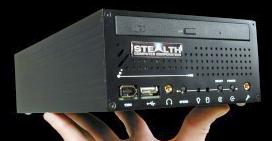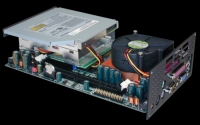Device profile: Netcordia Periscope Linux appliance for network analysis
Oct 22, 2003 — by LinuxDevices Staff — from the LinuxDevices Archive — 3 viewsNetcordia's Periscope “network analysis appliance” is a standalone expert system built on Linux and other open source software. The Periscope is plugged into a network and let to run for a day or so, at which point it should begin to display meaningful, concise, prioritized data on its “issues” interface: versions of Cisco IOS with memory leaks, duplex-mode errors between PCs… and switches, and unclean switch trunking, for example. Netcordia offers Periscope in a $24,900 configuration that supports up to 100 switches, and a $49,000 package supporting 250 switches.

Netcordia's Periscope PS-100
What does it do?
According to Netcordia's Product Architect, Dr. Frank Pittelli, Periscope:
- Gathers pertinent data through multiple data collection engines and specialized technologies integrated into the appliance to gain knowledge of the network topology, architecture and layout
- Analyzes gathered data using best practices and industry norms to create system level information about network operation and stability
- Coalesces and presents information to make it easy to view network issues and take action on those issues in a prioritized approach
Periscope first performs network and device discovery on networks falling within a configurable set of CIDR block addresses. It then uses SNMP read-only to collect device data, primarily on routers and switches. The data are analyzed to produce a Network Health Summary report that includes:
- Device summary (how many of which devices)
- Device details (drill-down to a device and its interfaces and other stats)
- Subnets (must be connected to a router interface) and membership
- List of sources of all routes in the routing tables
- Vlans, including root bridge in each vlan and a list of switches in each vlan
- HSRP, identifying active router and showing all routers in the group
- Top N interfaces for broadcasts, utilization, errors, etc
- List of issues we've detected on the network, sorted by Errors, Warnings, Info
What's inside the box?

Inside the Periscope PS-100
The Periscope PS-100 supports up to 100 switches and is housed in a small appliance case measuring 3 x 6 x 10 inches. It is powered by a 2.53GHz Pentium 4 processor and includes 1GB of RAM, an internal 40GB Hard drive, and a 10/100 Ethernet port.
The PS-250 can handle 250 switches, and lives in a 1U rackmount case. It is based on dual 3.0GHz Xeon processors and comes with 2GB of RAM, dual 30GB internal SCSI disks, and dual 10/100/1000 Ethernet ports.
Netcordia's Linux and Open Source Software experience
Periscope's “embedded” OS is based on Red Hat 8.0. No display is attached; instead, an HTTP interface is provided. A variety of open source applications are incorporated in the device, including a MySQL database.
Pittelli says Netcordia selected Linux because it allowed them to use inexpensive Intel platforms and provide high levels of reliability. “We have had no major problems with Linux over the years and we would not consider any OS capable of replacing it at this time or in the near future. The vast public support structure for Linux allows us to quickly resolve issues, find new resources, and make changes as needed to suit our requirements.”
Pittelli says that all Linux development and support was done by internal staff, most of whom had only limited Linux exposure at the outset. But, he says, they quickly adapted their skills from other operating systems to work effectively in Linux. “Over time, they have become very skilled in certain areas, such as BIOS interfaces and application performance tuning, as needed during the typical product development cycle.”
Pettelli said that using Linux contributed to a relatively short development time: the complex project was completed in just six months by a development team of three. However, keeping pace with the fast development cycles typical of active open source projects presented its own challenge. “The huge array of public domain packages available for Linux covers most of the features that were required by our product, and the quality of most of them is rock-solid. The only drawback, albeit minor, was keeping up with all of the new features being added in each of those packages and rolling them into our development schedule. New features in each package reduce the need for more custom coding, but they take time themselves to be incorporated.”
Development retrospective, and the future of Linux-based network appliances
Pettelli predicts that the use of Linux in network appliances will continue to grow as more product development teams realize the large savings in time and money that are possible. “The combination of Linux and public domain packages like MySQL significantly reduces start-up time and money, allowing a development team to explore more alternatives in a shorter period of time. Such rapid prototyping solidifies and improves the design of the product much earlier in the product development cycle, making the first release more capable and more stable than can otherwise be achieved.”
Dr. Pettelli emphasizes the importance of using Linux in network appliances: “Companies that don't use Linux as the basis for their network appliances will soon find themselves playing catch-up to those that do.”
This article was originally published on LinuxDevices.com and has been donated to the open source community by QuinStreet Inc. Please visit LinuxToday.com for up-to-date news and articles about Linux and open source.